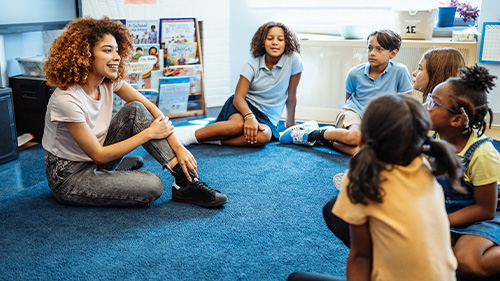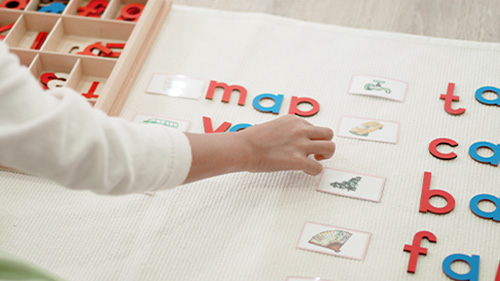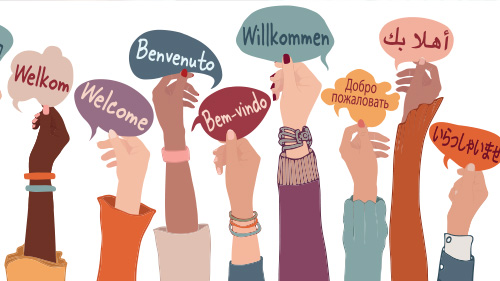Tackling Literacy Challenges for Emergent Bilingual Middle Schoolers
Do you ever have one of those days where you ponder, “What on Earth am I doing, and am I doing it right???” I did. Often. And they were often...
AP & Honors Mathematics
Explore Wiley titles to support both AP and Honors mathematics instruction.
Literacy Skills & Intensive Reading
Connections: Reading – Grades 6–12
Empower student success with a proven intensive reading program that develops strong reading skills in striving readers.
Drama, Speech & Debate
Basic Drama Projects 10th Edition
Build students’ confidence and competence with comprehensive, project-based theatre instruction.
Literature
Connections: Literature
Support learners as they study dynamic, relevant texts and bring the richness of diverse voices to students through literature.
Literature & Thought
Develop critical thinking, reading, and writing across literacy themes, genres, historical eras, and current events.
Language Arts
Vocabu-Lit® – Grades 6–12
Help students build word power using high-quality contemporary and classic literature, nonfiction, essays, and more.
Connections: Writing & Language
Help students develop grammar, usage, mechanics, vocabulary, spelling, and writing and editing skills.
Reading/English Language Arts
Measuring Up to the English Language Arts Standards
Incorporate standards-driven teaching strategies to complement your ELA curriculum.
English Language Learners
Measuring Up for English Language Learners
Incorporate research-based best practices for ELLs with an approach that includes a focus on language acquisition strategies.
Mathematics
Measuring Up to the Mathematics Standards
Incorporate standards-driven teaching strategies to complement your mathematics curriculum.
Foundations
Measuring Up Foundations
Help students master foundational math skills that are critical for students to find academic success.
Science
Measuring Up to the Next Generation Science Standards
Give students comprehensive NGSS coverage while targeting instruction and providing rigorous standards practice.
Assessment
Measuring Up Live
Deliver innovative assessment and practice technology designed to offer data-driven instructional support.
For a better website experience, please confirm you are in:
3 min read
Dr. Almitra Berry Oct 18, 2023 1:34:00 PM
.jpg)
Congratulations! You’re well into the first semester now. You’re developing new and solid relationships with your learners and creating a classroom culture of inclusion and learner safety.
The sixth graders aren’t quite squirrelly yet and the eighth graders are starting to resemble responsible learners again. Seventh graders? Well, they are in that unique stage of adolescent development where their brains are starting to be pruned, eliminating old and inefficient neuropathways. And parents may be wondering what happened to that delightful child they once knew.
Your learners may be comprised of a myriad of cultural and linguistic backgrounds, or perhaps just one or two. But each child is in their own stage of language development in one or more languages. Yes, each child. Even if their only identified language is English.
Unless they arrive on our doorsteps in kindergarten, ever having only heard and spoken academic or “school English,” we must consider them emergent bilingual learners.
These adolescents are still in the process of acquiring proficiency in English, particularly cognitive academic language proficiency, or CALP. At the same time, they continue to develop skills in their native or primary language – world, heritage, tribal, or sociocultural.
Identifying these learners as emergent bilinguals emphasizes the asset of bilingualism and recognizes their potential to become fully proficient in multiple languages.
Bilingualism is a wonderful skill, particularly in a world that is, and will continue to become, ever more connected as your middle grade learners exit into the world of higher education and the workforce over the next five to seven years.
But how do you leverage their diversity of languages and create greater opportunities for engagement and academic growth in your classroom?
Here are my top four tips and strategies for turning language diversity challenges into learning opportunities:
In my last blog, I suggested writing an inclusion statement. A statement of learning follows a similar vein. Begin with the stem: “This classroom is a place where...” Then ask your learners to contribute their own ideas.
Ask them to share the fears they have about learning your subject matter, or even just being comfortable in your room.
And just like your inclusion statement, your final product should be prominently displayed to serve as a reminder of the inclusive culture of the classroom.
Now, they may not feel safe sharing to the whole group, so let’s use my second strategy for supporting that safe space.
Heterogeneous groups are great! But there are times when learners may engage to a greater degree, and make stronger connections to the content, when they can collaborate in small groups where they share cultural or linguistic identity or lived experiences.
And if you have broad variation in achievement, why not create opportunities for advanced learners to work in small groups on enrichment? This will free you up to provide targeted small-group instruction to struggling or emergent bilingual learners at lower levels of English language proficiency.
It’s not only helpful for your learners to be allowed to leverage their bilingualism when working on their own, but also if you leverage your own bilingualism.
If you’ve got it, use it! If you can translanguage or code-switch, do so! If it helps with learner engagement and comprehension, it’s a tool in your toolkit to increase engagement, achievement, and illustrate that your classroom is a safe space for everyone to learn.
Now, given the level of linguistic diversity in some classrooms, it would be absurd to think that you can speak the languages of all your learners. But you have the opportunity to let your learners teach you, and their peers, a word or two. Just make sure you also reference an online language dictionary, just to be safe.
Every subject taught relies on reading and language comprehension. And student writing ability trails their reading ability.
Forget about word walls! Context is key. Bulletin boards that use visuals along with words support learners' use of context clues for comprehension.
Refine your skills in modeling. Read aloud to your learners to support their hearing of expository text with prosody.
Borrow graphic organizers from your ELA teacher peers if your science, social science, and math programs don’t make them available.
Check for understanding frequently and provide corrective feedback when your learners misunderstand.
These strategies support an asset-based approach to multilingualism. They support emergent bilingual learners, while not harm your English-only learners. They create spaces where learners are open to what you’re teaching and want to engage, bringing a little bit of joy to you and your learners.
Dr. Almitra L. Berry is an educational consultant, author, and podcaster. She contributed to the review of emergent bilingual supports in Connections: English Language Arts. Dr. Berry covers the topic of emergent bilingual learners extensively in her book Effecting Change for Culturally and Linguistically Diverse Learners and in several episodes of the Educational Equity Emancipation podcast.

Do you ever have one of those days where you ponder, “What on Earth am I doing, and am I doing it right???” I did. Often. And they were often...

In my last post, I shared the success stories of two of my multilingual learners. I told you I used strategies, but I didn’t share which ones.

It’s that time! The school year is beginning and you’re ready to welcome up to 180 new learners into your classroom. Whether you’re in your first...

Walk into a middle school classroom during a lively literature circle and you’ll hear questions, laughter, debate, and—most important—learners...

When I think about the success stories of my middle school emergent bilingual learners, I can’t help but smile. What about you? Sure, there were...

The summer break is winding down, and soon you'll be setting up your classroom for another year of learning adventures. Whether you're a first-year...

In American K-12 public schools, English language learners (ELLs) make up over 10% of students. 10% may not sound like much, but that’s over 5...

As middle school educators, we know the moment when a learner comes alive in class. Maybe they're debating a character's motivation or crafting a...

What happens when we stop seeing language diversity as a barrier and start embracing it as our greatest classroom asset?

Toward the latter half of my son’s junior year in high school (he’s a junior in college now), I went with him to the meetings set up by the...

We’ve heard of Project-Based Learning (PBLs), which allows students to mostly have independent leadership through a task or project and creative...

With schools thrust into online education models, it is more important than ever to ensure the proper support is in place for all students. How can...
